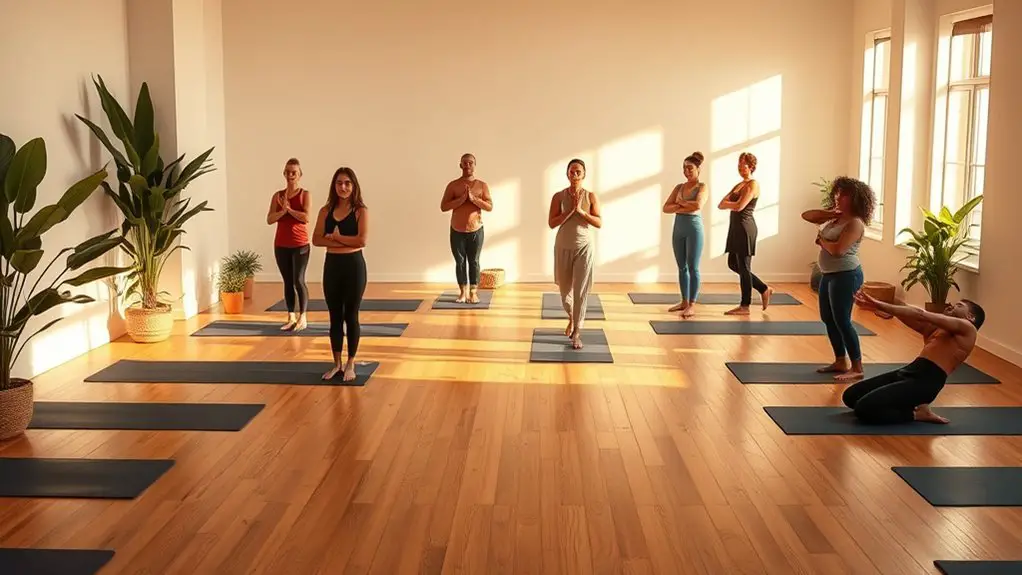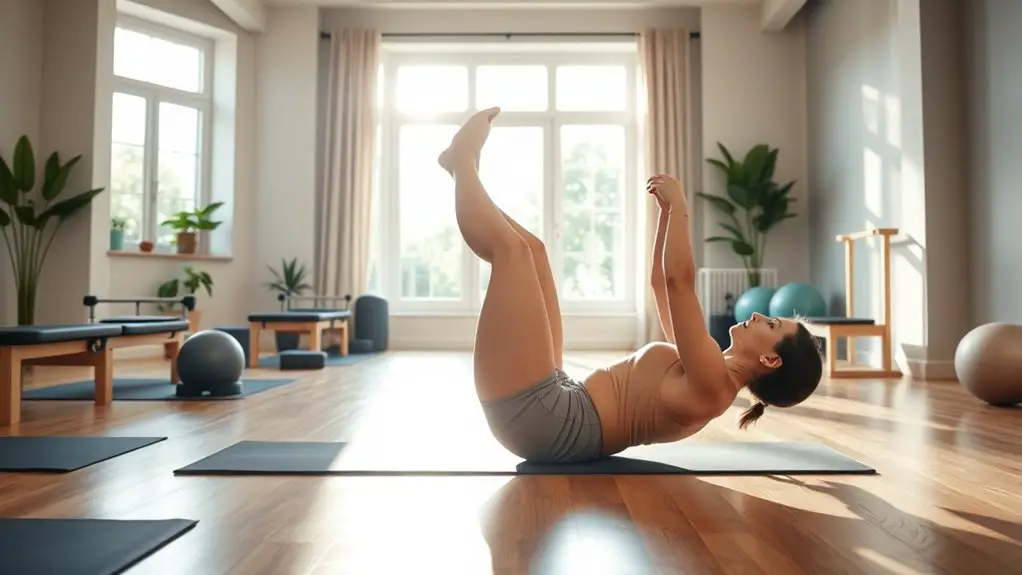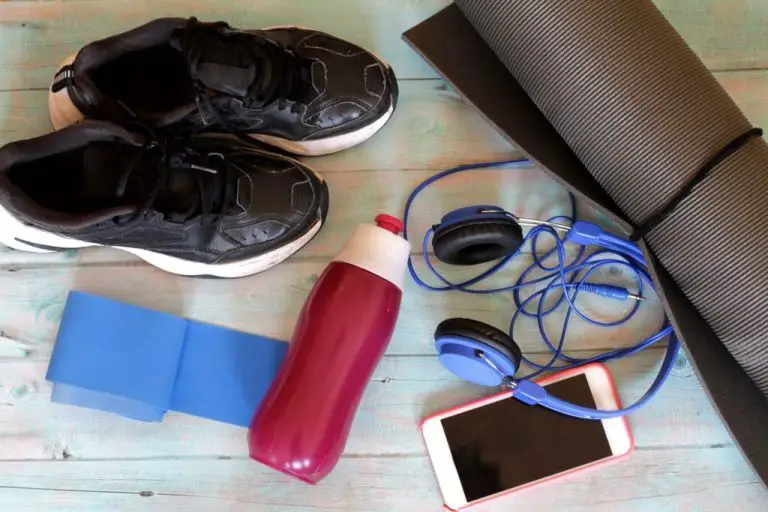The Best Gym Workouts for Stress Relief

To relieve stress at the gym, incorporate High-Intensity Interval Training (HIIT) for quick bursts of energy and endorphins. Pair it with strength training to build muscle and boost your mood. Don’t forget cardio workouts for heart health and stamina. Add yoga or Pilates to enhance mindfulness and core strength. Joining group fitness classes or dance workouts can lift your spirits through community engagement. There’s so much more to discover that can elevate your fitness experience.
High-Intensity Interval Training (HIIT)

When you’re feeling overwhelmed by stress, High-Intensity Interval Training (HIIT) can be a game changer. This dynamic workout method combines short bursts of intense exercise with brief recovery periods, making it highly effective for both your body and mind. One of the key HIIT benefits is that it boosts your endorphin levels, giving you that much-needed mood lift. You’ll find that even a 20-minute session can leave you feeling energized and accomplished.
Using various HIIT techniques, like sprints, jumping jacks, or burpees, you can tailor your workout to fit your fitness level. Plus, it’s time-efficient, so you can squeeze in a session even on your busiest days. Each workout not only enhances your physical strength but also provides a mental reset, helping you tackle stress head-on. So, give HIIT a try, and watch how it transforms your stress into strength!
Strength Training
If you’re looking for another effective way to manage stress, strength training might be what you need. This powerful workout not only builds muscle but also boosts your mood by releasing endorphins. Incorporating compound movements, like squats and deadlifts, targets multiple muscle groups, maximizing your effort in less time.
To truly reap the benefits, focus on progressive overload, gradually increasing the weight or resistance you lift. This approach not only enhances your physical strength but also fosters a sense of accomplishment, which can greatly reduce stress levels. Monitoring personal benchmarks over time can also help you stay motivated and see your progress.
As you push your limits, you’ll find an empowering release, turning your frustrations into focused energy. Remember, each rep is a step towards feeling stronger, both physically and mentally. So, grab those weights and channel your stress into strength—your body and mind will thank you!
Cardiovascular Workouts

Cardiovascular workouts are a fantastic way to boost your mood and reduce stress. Not only do they improve your heart health, but they also release those feel-good endorphins that help you tackle life’s challenges. Let’s explore some effective cardio exercises and tips on duration and intensity to maximize your stress relief! Incorporating jump rope workouts can provide an excellent cardiovascular workout while enhancing your coordination and stamina.
Benefits of Cardio Workouts
Engaging in cardio workouts can be a game-changer for your mental and physical health. Regularly elevating your heart rate not only boosts your stamina but also releases endorphins that help reduce stress and anxiety. By varying your cardio intensity, you can tailor each session to match your mood and energy levels, making workouts more enjoyable. Plus, maintaining a consistent workout frequency—aiming for at least three to five times a week—ensures you reap the maximum benefits. Over time, you’ll notice improved mood, better sleep, and enhanced focus. So, lace up those sneakers and commit to a cardio routine; your mind and body will thank you for it!
Recommended Cardio Exercises
Looking to elevate your fitness routine? Incorporating cardio exercises is a fantastic way to relieve stress while boosting your overall health. Treadmill variations, like incline walking or interval sprints, can keep your workouts fresh and exciting. They challenge your body differently, helping you burn calories and improve cardiovascular endurance.
On the other hand, cycling offers its own unique benefits. Whether you’re on a stationary bike or hitting the road, cycling can enhance your mood and build lower body strength. Plus, it’s low-impact, making it easier on your joints. So, mix up your cardio with treadmill variations and enjoy the cycling benefits to keep your workouts engaging and effective. You’ll feel the stress melt away while achieving your fitness goals!
Duration and Intensity Tips
To maximize the benefits of your cardio workouts, understanding the right duration and intensity is key. Here are some tips to help you hit the sweet spot:
- Duration Guidelines: Aim for at least 150 minutes of moderate-intensity cardio each week. This could mean 30 minutes, five times a week.
- Intensity Levels: Incorporate a mix of low, moderate, and high-intensity sessions. Use the talk test—if you can’t talk comfortably, you’re likely at a higher intensity.
- Interval Training: Boost your efficiency by adding intervals. Alternate between bursts of high intensity and recovery periods to enhance endurance and burn more calories.
Yoga and Mindfulness

Yoga and mindfulness are powerful tools for relieving stress and enhancing your overall well-being. By incorporating breathwork practices and mindfulness techniques into your routine, you can cultivate a deeper sense of calm and focus. Let’s explore how these practices can transform your gym experience and promote inner peace.
Benefits of Yoga
Finding inner peace in today’s fast-paced world can be a challenge, but incorporating yoga into your routine can offer profound benefits for both your body and mind. Different yoga styles can help you find the right fit for your needs, enhancing your practice and overall well-being. Here are three key benefits of yoga:
- Improved Flexibility: Regular practice can help you achieve greater flexibility, reducing the risk of injuries.
- Enhanced Mental Clarity: Engaging in yoga helps clear your mind, allowing for improved focus and decision-making.
- Stress Reduction: The combination of physical movement and mindful breathing reduces stress levels, promoting a sense of calm.
Embracing yoga can be a transformative journey, leading you toward a healthier, more balanced life.
Mindfulness Techniques Explained
Many people are discovering the power of mindfulness techniques to enhance their yoga practice and overall well-being. Integrating mindful breathing into your routine can create a deeper connection between your body and mind. Focus on your breath—inhale deeply through your nose, hold for a moment, and exhale slowly through your mouth. This simple technique helps silence distractions and calms your thoughts.
In addition, try incorporating meditation techniques into your sessions. Whether it’s guided meditation or simply sitting in silence, these practices encourage self-awareness and reduce stress. As you cultivate mindfulness, you’ll find that your yoga practice becomes more fulfilling and your daily life less overwhelming. Embrace these techniques, and you’ll reveal a new level of tranquility and resilience.
Incorporating Breathwork Practices
While you may already be familiar with the benefits of yoga and mindfulness, incorporating breathwork practices can take your experience to a whole new level. Breath awareness and mindful breathing are essential tools for managing stress and enhancing your workouts. Here are three effective methods to integrate breathwork into your routine:
- Diaphragmatic Breathing: Focus on deep belly breaths, which can help lower your heart rate and promote relaxation.
- Box Breathing: Inhale for four counts, hold for four, exhale for four, and hold again for four. This technique calms the mind and sharpens focus.
- Alternate Nostril Breathing: This practice balances the body’s energy and reduces anxiety, making it perfect before or after workouts.
Incorporate these techniques, and you’ll find stress relief becomes even more attainable.
Pilates for Core Strength

If you’re looking to strengthen your core while also relieving stress, Pilates offers a perfect blend of both. This workout focuses on core stability, which is essential for overall strength and balance. By practicing Pilates techniques, you’ll engage your abdominal muscles, improve posture, and support your spine.
Each movement is intentional, allowing you to connect your mind and body, which can greatly reduce stress levels. You’ll learn to control your breath and movement, enhancing your mental clarity and focus.
As you progress, you’ll notice increased flexibility and strength, making everyday activities easier. Plus, the calming atmosphere of a Pilates session encourages relaxation, helping to melt away tension.
Group Fitness Classes
Group fitness classes can be a fantastic way to relieve stress while enjoying the motivation of a community. The energy of group dynamics can uplift your spirits and enhance your workout experience. Here are three reasons why you should consider joining a class:
- Shared Goals: Being surrounded by others working towards similar fitness goals can boost your class motivation, making you more likely to push yourself.
- Supportive Environment: The camaraderie in group settings fosters encouragement, allowing you to feel connected and supported, which can notably reduce stress.
- Variety of Classes: From HIIT to yoga, there’s a class for everyone. Trying different formats keeps your workouts fresh and exciting, preventing burnout.
Dance Workouts

Incorporating dance workouts into your routine can elevate stress relief to a whole new level. Whether you’re grooving to Zumba, hip-hop, or ballet, each dance style offers unique fitness benefits that can lift your spirits and improve your mood. Dancing not only provides a fantastic cardiovascular workout but also enhances coordination and flexibility, making it a fun way to get fit.
As you move to the rhythm, you’ll find that the endorphins released can help combat anxiety and tension. Plus, the social aspect of dance workouts can foster connections with others, creating a supportive community that boosts your emotional well-being.
Outdoor Workouts and Fresh Air
While you might enjoy your gym workouts, stepping outside can take your stress relief to another level. Outdoor workouts not only give you a break from the usual routine but also immerse you in nature, enhancing your connection to the environment. Here are three ways to incorporate outdoor mindfulness into your fitness regimen:
Stepping outside for workouts enhances stress relief while deepening your connection to nature.
- Nature Walks: Slow down and appreciate your surroundings while walking. Focus on the sights, sounds, and smells to calm your mind.
- Yoga in the Park: Practicing yoga outdoors combines physical movement with the tranquility of nature, promoting relaxation and mindfulness.
- Trail Running: Experience the thrill of running on varied terrains. It’s a great way to boost your mood while enjoying the fresh air.
Frequently Asked Questions
How Often Should I Work Out for Stress Relief?
To relieve stress effectively, you should aim for at least three to five workouts per week. Consistency in frequency benefits both your physical and mental health, helping you manage stress more efficiently and feel better overall.
Can I Combine Different Workout Types for Stress Relief?
Why settle for just one workout when you can blend them? Combining yoga benefits with cardio combinations not only enhances your fitness but also amplifies stress relief, ensuring you feel rejuvenated and balanced after each session.
What Should I Eat Before a Stress-Relief Workout?
Before your workout, grab some pre-workout snacks like bananas or yogurt. Don’t forget hydration tips—drink water to stay energized. You’ll feel great and ready to tackle stress, making your workout more effective and enjoyable!
How Long Should My Workouts Be for Maximum Stress Relief?
Research shows that 30 minutes of moderate exercise can reduce stress hormones considerably. For ideal intensity, aim for 30 to 60 minutes per workout; this duration balances effectiveness and enjoyment, maximizing your stress relief benefits.
Are There Any Specific Exercises to Avoid for Stress Relief?
When considering stress relief, you might wanna avoid high impact exercises and intense cardio, as they can increase anxiety levels. Instead, focus on low-impact activities like yoga or walking to promote relaxation and calm your mind.





